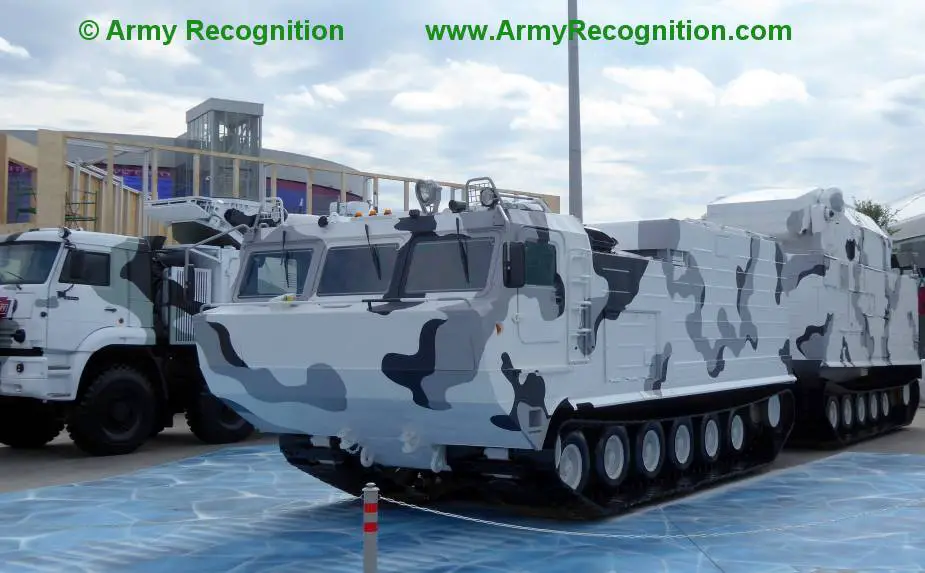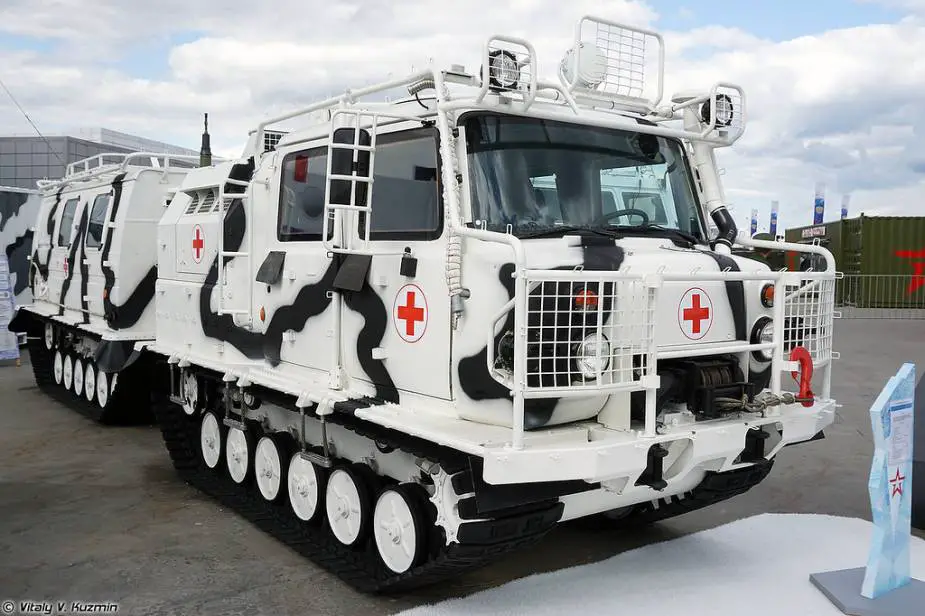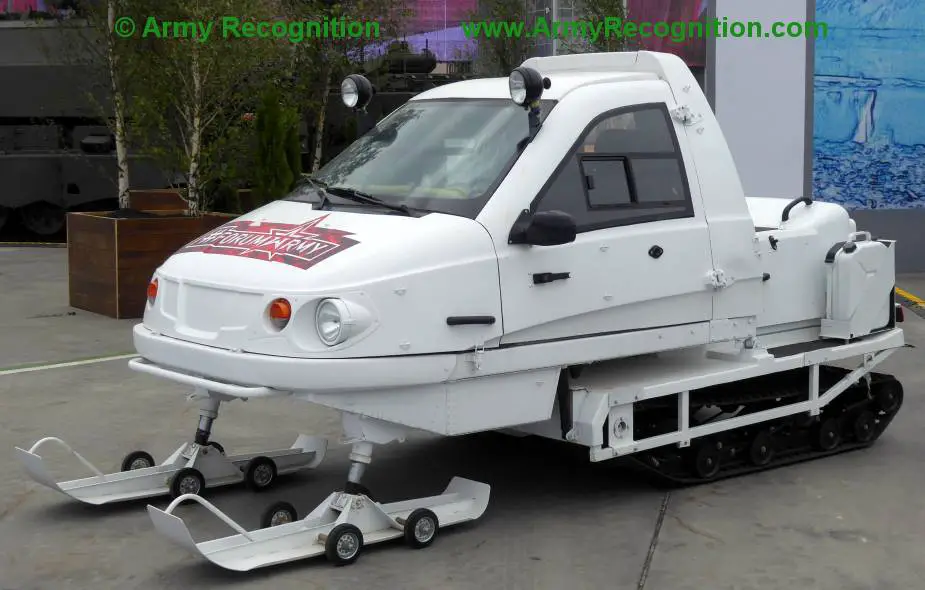Russian army to get several new Arctic vehicles - Part 1
The Northern fleet held a large-scale exercise in the Barents, Kara, and Laptev Seas near Novosibirsk Islands and Franz-Joseph Land Archipelago. Besides aircraft, warships and supply vessels, it engaged close to 800 hardware units, including 460 combat armored vehicles. The Defense Ministry demonstrated the hardware fit for Arctic operations, the Krasnaya Zvezda newspaper writes.
Follow Army Recognition on Google News at this link

Tor-M2DT (Picture source: Army Recognition)
The basics of the Arctic state policy up to 2020 were approved in the autumn of 2008. One of the main tasks was to create a combined arms force in the Russian Arctic. The new policy up to 2035 sets the task to equip the force with modern snow-and-swamp-going vehicles.
Marshlands, lakes and tundra dominate in the Extreme North. The climate is harsh and the atmospheric parameters sharply change. In winter, the air temperature is extremely cold and the land is covered with dense snow that can sustain high weight and dynamic load. Strong winds create snowdrifts, which produce cross-country terrain. Together with an undeveloped road network, it makes it hard to access the region on ordinary automobiles.
The Army-2021 forum included the Arctic exposition. A conference was held on the state and prospects of military vehicles for the Arctic. The event was organized by the Main armor department and was attended by close to 60 representatives of over 30 military command bodies, research institutes and defense enterprises.
The Defense Ministry is equipping the Arctic troops with modern arms and hardware. The GABTU, the 21st Research Institute of Military Automobiles (NIII), the 25th Research Institute of Chemmotology (GosNII) are engaged in the work. They coordinate operations and implement various projects to design Arctic automobiles.
R&D and practical research were held in 2008-2017 to study the effectiveness of snow-and-swamp-going vehicles and other ground transportation means in the Arctic. They created the required normative and legal base, tactical and technical requirements for R&D of prospective Arctic hardware.
The research showed the combined arms units in the Arctic need a new fleet of vehicles. It was proposed to switch to a single snow-and-swamp-going light-armor two-section tracked undercarriage with a carrying capacity of four tons. It has to carry light arms, which used to be mounted on over ten types of tracked and wheeled hardware and armor.
The outdated undercarriages of 6-30 tons are replaced by a unified family of Vezdesushchy snow-and-swamp-going two-section tracked vehicles (DT-10PN, DT-20PM, DT-30PM with a carrying capacity of 10, 20, and 30 tons respectively). The outdated single-section unarmored snow-and-swamp-going tracked prime movers GT-SM and GT-T with a carrying capacity of 1-2 tons are to be replaced with unarmored GAZ-3344-20 with a three-ton capacity.

DGT-S medical vehicle on GAZ-3344-20 chassis (Picture source: Vitaly Kuzmin)
Arctic units also need multirole wheeled vehicles. Two upgrades are planned. The first one is to create KhL (cold climate) modifications of Ural and KAMAZ trucks capable of operating in air temperature of minus 60 degrees Centigrade. The upgrade has been fulfilled. The second one has to increase all-terrain capacity due to low-pressure tires of a bigger radius. The upgrade is ongoing.
The fleet of wheeled vehicles has also to include cross-country transportation means on super low-pressure Trekol tires operated by the armed forces.
Snow-and-swamp-going vehicles with a cabin and wheeled all-terrain double and triple axis vehicles developed from civilian automobiles upon Defense Ministry requirements are another prospective guideline.
The R&D results were reflected in the development concept of the types of military automobiles, the types of army automobiles up to 2025, and the list of military automobiles for the armed forces up to 2030.
The research, the adopted normative and legal base, and cooperation with defense enterprises successfully equipped the armed forces with new serial Arctic automobiles. The upgrade of available vehicles is envisaged for operation in low Arctic temperatures. Technical assignments and R&D are planned to design new-generation undercarriages.
Thus, the scientifically substantiated Arctic hardware proposals have been implemented practically in full. Close to a dozen various military automobiles have been accepted into service and are procured. The effectiveness of the Vezdesushchy upgrade was confirmed by 2014 trials and the Arctic expedition in 2017. Ural and KAMAZ cold-weather trucks were upgraded and tested. Work is ongoing to create REM-GT evacuation and overhaul vehicle on DT-30PM undercarriage.
The list of military automobiles for 2020-2031 and the concept of automobile overhaul up to 2025 determined the main development guidelines of Arctic hardware. The vehicles will be upgraded according to the operational experience and as the current R&D are completed.
Another guideline is an upgrade of snow and all-terrain vehicles, the creation of KAMAZ and Ural Arctic modifications on arched and low-pressure tires and of a 6x6 army all-terrain vehicle. It has to enjoy expanded engagement capabilities for cross-country terrain, snow and water. Maintenance and overhaul Arctic container vehicles on the undercarriage of cold-weather trucks have also to be created.
The Defense Ministry has introduced stricter requirements to Arctic operations. The designed vehicles have to operate in temperatures of minus 60 degrees Centigrade. It demanded to deal with several complicated tasks. The requirements demand to use fuel and lubricants with a corresponding temperature regime.
Arctic military automobiles need technical maintenance, as any vehicle has to be ready for immediate engagement in the harsh climate. Some tasks have been fulfilled already.
New heated maintenance and overhaul facilities were constructed in the Arctic with modern technologies. The Arctic Trilistnik base operates in Franz-Joseph Land and the Severny Klever in Kotelny Island. In the absence of stationary warehouses, it is appropriate to keep, service and overhaul vehicles in individual and group carcass or inflated heated tents in the Arctic.

TTM 1901-40 (Picture source: Army Recognition)
© Copyright 2021 TASS / Army Recognition Group SPRL. All rights reserved. This material may not be published, broadcast, rewritten or redistributed.


























